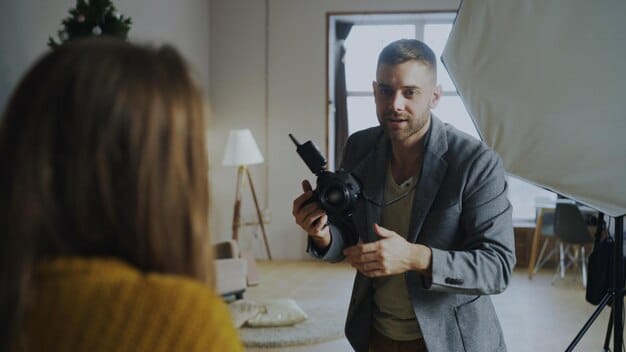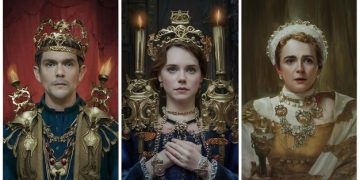Limited Series Directing Styles: A Comparative Analysis

Limited series directing styles significantly impact the narrative and visual storytelling; this article explores the unique approaches of three notable directors, analyzing their methods and contributions of those styles to the limited series format.
The world of limited series offers directors a unique canvas to showcase their storytelling prowess. Exploring the diverse directing styles can provide insight into how narratives are shaped and brought to life. This article delves into the limited series directing styles of three notable directors, offering a comparative analysis of their distinct approaches.
Understanding Directing Styles in Limited Series
Directing styles in limited series are crucial in setting the tone, pacing, and visual aesthetics of the show. The director’s approach influences everything from the actors’ performances to the editing and cinematography. Understanding these nuances allows viewers to appreciate the artistry involved in crafting a compelling limited series.
The Role of a Director
The director is essentially the captain of the ship in any film or television production, and this hold especially true for limited series. They are responsible for interpreting the script, guiding the actors, and making key decisions about the visual style and overall feel of the show. The director’s vision is what ultimately shapes the final product.
Why Directing Matters in Limited Series
Limited series, unlike ongoing television shows, have a defined beginning, middle, and end. This format allows directors to craft a complete and cohesive narrative arc. The directing style must be consistent throughout the series to maintain the intended tone and impact.

Directing is also a key aspect allowing for visual storytelling, where the style of filming tells a story of its own; below are core components:
- Visual Storytelling: The director uses camera angles, movement, and composition to convey emotion and meaning.
- Performance Shaping: The director guides the actors to deliver nuanced and compelling performances.
- Maintaining Consistency: Ensuring a consistent tone and style across all episodes of the limited series.
Ultimately, the director’s role is pivotal in setting the tone and overall appeal of the series, and in weaving together all involved, in creating that appeal.
The Auteur Approach of Jean-Marc Vallée
Jean-Marc Vallée was a director known for his unique auteur approach, characterized by naturalistic performances, improvisational dialogue, and distinctive visual style. His work often explored complex emotional themes and featured strong female characters.
Distinctive Visual Techniques
Vallée’s visual style often involved the use of handheld cameras, natural lighting, and unconventional editing techniques. He was known for creating a sense of intimacy and immediacy in his work, drawing the viewer into the characters’ inner worlds.
Notable Limited Series: Big Little Lies
One of Vallée’s most acclaimed limited series was “Big Little Lies.” The show, which explores the lives of affluent women in Monterey, California, showcased Vallée’s talents for crafting complex characters and creating a gripping narrative.
Some key elements of Big Little Lies which define Vallée’s aesthetic:
- Handheld Camera Work: Creates a sense of realism and intimacy.
- Natural Lighting: Enhances the authenticity of the performances.
- Improvisational Dialogue: Adds to the spontaneity and naturalness of the conversations.
Vallée’s auteur approach brought a unique and artistic sensibility to “Big Little Lies,” which greatly contributed to the success of the series, and established many of the actors on the show as the A list that many know them as today.
The Stylized Realism of Susanne Bier
Susanne Bier is a Danish director renowned for her ability to blend stylized visuals with realistic emotional portrayals. Her films and TV series often explore complex family dynamics and social issues, with a keen eye for human psychology.
Balancing Style and Substance
Bier’s directing style is characterized by a delicate balance between aesthetic beauty and emotional depth. She uses visual techniques to enhance the emotional impact of the story, without sacrificing the realism of the characters and their situations.
Notable Limited Series: The Night Manager
“The Night Manager,” a spy thriller based on the novel by John le Carré, is a prime example of Bier’s stylized realism. The series combines thrilling action sequences with nuanced character development and explores themes of morality and redemption with an attention to depth.
She also places a strong emphasis on high-stakes storytelling:
- Elegant Visual Techniques: Enhances the suspense and drama of the plot.
- Nuanced Character Development: Adds depth and complexity to the characters.
- Exploration of Moral Ambiguity: Raises thought-provoking questions about right and wrong.
Bier’s stylized realism brought a sophisticated and intellectually stimulating quality to “The Night Manager,” making it a standout in the spy thriller genre, and further cementing her position as a top director in modern cinema.
The Visceral Storytelling of Cary Joji Fukunaga
Cary Joji Fukunaga is celebrated for his visceral and immersive storytelling, often employing striking visuals and unconventional narrative structures. His work delves into the darker aspects of human nature, exploring themes of trauma, identity, and redemption.
Immersive Narrative Techniques
Fukunaga’s directorial style utilizes long takes, dynamic camera movements, and atmospheric cinematography to immerse the viewer in the story. He creates a sense of tension and unease, drawing the audience into the emotional core of the characters.
Notable Limited Series: Maniac
In “Maniac”, Fukunaga showcases his ability to blend genres and create visually stunning worlds. A dark comedy series which is both visually and emotionally engaging for the audience.
Fukunaga also creates a dream-like quality to the scenes, and relies on a feeling of unease:
- Long Takes and Dynamic Camera Movements: Creates a sense of flow and momentum.
- Atmospheric Cinematography: Enhances the mood and tone of the story.
- Exploration of Psychological Themes: Delves into the complex and often troubled minds of the characters.
In summary, Fukunaga has managed to bring a deeply disturbing, but ultimately beautiful and artistic, tone to modern cinema via the visceral experience he imbues within his films.
Comparing the Directing Styles
Jean-Marc Vallée, Susanne Bier, and Cary Joji Fukunaga each bring a unique set of skills and sensibilities to their work. While their styles differ, they all share a commitment to telling compelling stories and crafting memorable characters, and are constantly expanding the realm of cinematics.
Auteur vs. Stylized Realism vs. Visceral Storytelling
Vallée’s auteur approach emphasizes naturalism and intimacy, while Bier’s stylized realism blends aesthetic beauty with emotional depth. Fukunaga’s visceral storytelling immerses the viewer in the story through striking visuals and unconventional narrative structures.
Impact on Narrative and Visuals
Each director’s unique style has a profound impact on the narrative and visuals of their limited series. Vallée’s naturalistic approach allows for authentic and emotionally resonant performances, while Bier’s stylized realism enhances the suspense and drama of the plot. Fukunaga’s visceral storytelling creates a sense of unease and tension, drawing the audience into the emotional core of the characters.
The contrasts and comparisons can be highlighted as such:
- Vallée: Auteur approach with naturalistic performances and improvisational dialogue.
- Bier: Stylized realism that balances aesthetic beauty with emotional depth.
- Fukunaga: Visceral storytelling that immerses the viewer in the story through striking visuals.
Ultimately it can be said that though all are different, each director brings a sense of self, and artistic value, to modern cinema.
The Legacy of These Directors
The work of Jean-Marc Vallée, Susanne Bier, and Cary Joji Fukunaga has left a lasting impact on the world of television and film. Their innovative directing styles have inspired countless filmmakers and brought a new level of artistry to the limited series format.
Influence on Contemporary Filmmaking
These directors have pushed the boundaries of storytelling and visual aesthetics in contemporary filmmaking. Their work has demonstrated the power of the limited series format to explore complex themes and create compelling characters.
Contribution to the Limited Series Format
Vallée, Bier, and Fukunaga have each made significant contributions to the limited series format. Their innovative directing styles have elevated the medium and showed that it can be a platform for cinematic storytelling.
The impact of their films in popular culture can be seen in the following:
- Critical Acclaim: Their limited series have received widespread critical acclaim and won numerous awards.
- Audience Engagement: Their work has resonated with audiences around the world, sparking conversations and inspiring new perspectives.
- Artistic Innovation: Their directing styles have pushed the boundaries of storytelling and visual aesthetics, inspiring countless filmmakers.
It can be said, definitively, that the impact of these directors, as storytellers and innovators, on modern cinema, can be felt throughout the world, and that this impact will stay for years to come.
| Key Aspect | Brief Description |
|---|---|
| 🎬 Directing Style | Unique approaches vary between directors, influencing tone & aesthetics. |
| 🌟 Jean-Marc Vallée | Known for naturalism, handheld cameras, and improvisational dialogue. |
| 🎭 Susanne Bier | Blends stylized visuals with realistic emotional portrayals. |
| 🎥 Cary Joji Fukunaga | Employs visceral, immersive storytelling with striking visuals. |
FAQ
▼
A director’s style in a limited series is defined by their unique approach to visual storytelling, character development, and overall aesthetic. It includes their choice of camera angles, lighting, editing techniques, and their ability to elicit certain kinds or styles of perfomances from actors.
▼
Vallée was a champion of naturalism, using methods such as handheld cameras and natural lighting to enhance the intimacy and authenticity of emotional performances. His work revolutionized the naturalistic look in Tv and created new standards.
▼
Stylized realism blends elegant visuals with authentic emotion, using the tension between the two to create a deeper experience for the viewer. Bier uses it to add depth and complexity to her characters, and also to address moral ambiguities.
▼
Fukunaga uses long takes and dynamic camera movements, to create a cinematic landscape that wraps the action around the viewer. His goal is immersion, and he is a tireless pioneer in creating more believable on-screen realities.
▼
A limited series has a defined arc, giving the director complete control of the narrative and aesthetic. This allows them to design the entire show, making the limited series feel more like an extended movie.
Conclusion
In conclusion, the limited series directing styles of Jean-Marc Vallée, Susanne Bier, and Cary Joji Fukunaga showcase the diverse possibilities within the format. Their unique approaches to storytelling and visual aesthetics have enriched the medium and inspired countless filmmakers. They have each left a lasting impression on cinema, and are constantly expanding the realms of storytelling.





